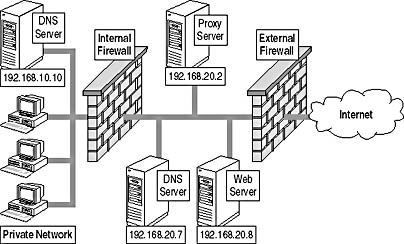Activity: Identifying Security Design Risks

You've been hired by an organization to maintain network security when their employees access the Internet. To deploy a solution based on the user's group memberships, you've decided to deploy Proxy Server 2.0 on the network and require that all Internet-bound communications be performed by Proxy Server 2.0 on behalf of the employees.
This activity examines how your security design changes according to the location of the Proxy Server within your organization's network. In this activity the design must meet the following requirements:
- All access from the private network to Internet-based resources must be performed through the Proxy Server.
- All access to the Web server in the DMZ must bypass the Proxy Server.
- Client computers can send DNS requests only to the DNS server located in the private network. The DNS server in the private network is the only computer that may contact the DNS server in the DMZ.
- The DNS server in the DMZ forwards all Internet-related DNS queries to the ISP's DNS server located at IP address 131.107.1.1.
Locating the Proxy on the Private Network
The first proposal for the network configuration places the Proxy Server on the private network, as shown in Figure 15.14.

Figure 15.14 Placing the Proxy Server for your organization on the private network
Based on the proposed location of the Proxy Server, answer the following questions. Answers to these questions can be found in the appendix.
- Assuming that the internal firewall processes packet filters in the order that they're listed in the packet filters list, which packet filters are required at the internal firewall to accomplish the following tasks?
- Allow private network client computers to access the Proxy Server
- Allow private network client computers to access the Web server in the DMZ using HTTP and HTTPS
- Restrict access to the DNS server in the DMZ to only the DNS server in the private network
- Allow the Proxy Server to access any resources on the Internet
- Prevent private network client computers from directly accessing the Internet
Protocol Source IP Source Port Target IP Target Port Transport Protocol Action HTTP HTTPS DNS DNS Any Any - What packet filters are required at the external firewall to allow only the Proxy Server to connect to Internet resources and to allow the external DNS server to forward DNS requests to the ISP's DNS server?
Protocol Source IP Source Port Target IP Target Port Transport Protocol Action DNS DNS Any - Does the external firewall require a packet filter to prevent the private network clients from connecting to the Internet?
Answers
Locating the Proxy in the DMZ
The second proposal for the network configuration places the Proxy Server in the DMZ, as shown in Figure 15.15.

Figure 15.15 The Proxy Server location for your organization
Based on the proposed location of the Proxy Server, answer the following questions. Answers to the questions can be found in the appendix.
- Assuming that the internal firewall processes packet filters in the order that they're listed in the packet filters list, what packet filters are required at the internal firewall to accomplish the following tasks?
- Allow private network client computers to access the Proxy Server
- Allow private network client computers to access the Web server in the DMZ using HTTP and HTTPS
- Restrict access to the DNS server in the DMZ to only the DNS server in the private network
- Allow the Proxy Server to access any resources on the Internet
- Prevent private network client computers from directly accessing the Internet
Protocol Source IP Source Port Target IP Target Port Transport Protocol Action HTTP HTTPS DNS DNS Any Any - Does the internal firewall require a packet filter for outbound traffic from the Proxy Server?
- What packet filters are required at the external firewall to allow only the Proxy Server to connect to Internet resources and to allow the external DNS server to forward DNS requests to the ISP's DNS server?
Protocol Source IP Source Port Target IP Target Port Transport Protocol Action DNS DNS Any
Answers
EAN: 2147483647
Pages: 172
- Chapter II Information Search on the Internet: A Causal Model
- Chapter X Converting Browsers to Buyers: Key Considerations in Designing Business-to-Consumer Web Sites
- Chapter XIII Shopping Agent Web Sites: A Comparative Shopping Environment
- Chapter XVI Turning Web Surfers into Loyal Customers: Cognitive Lock-In Through Interface Design and Web Site Usability
- Chapter XVII Internet Markets and E-Loyalty